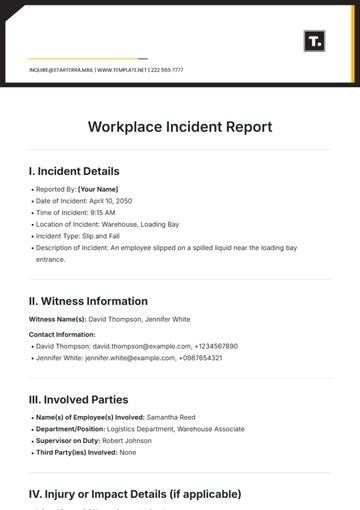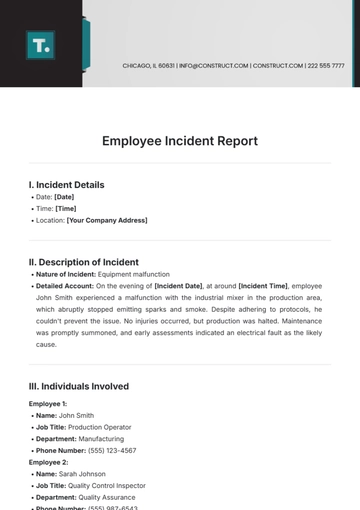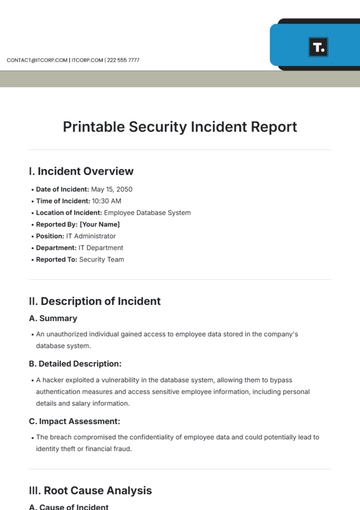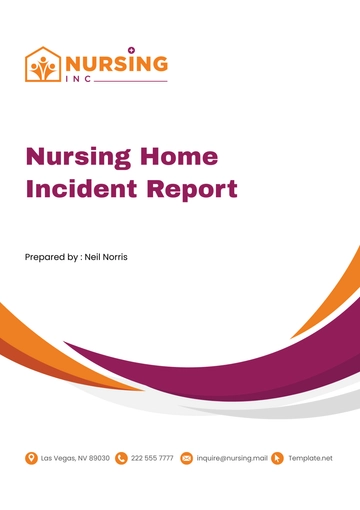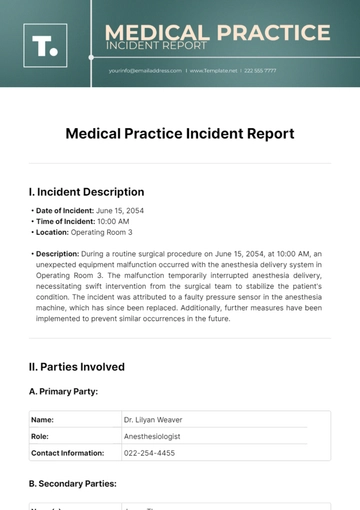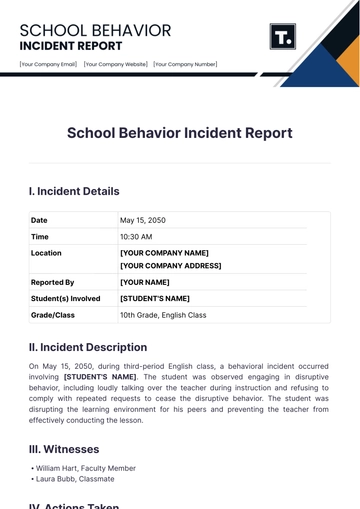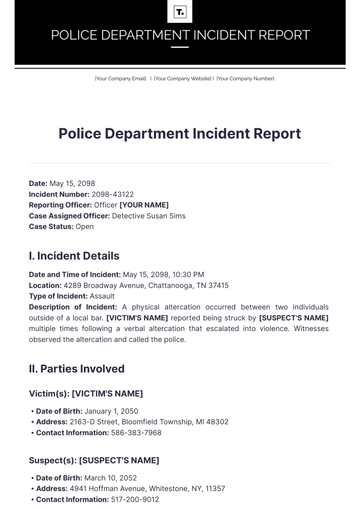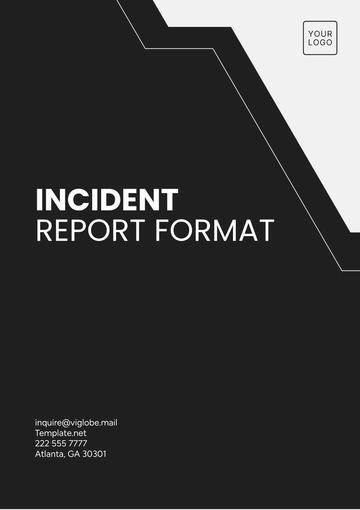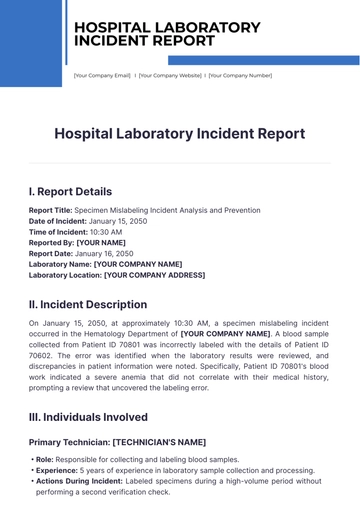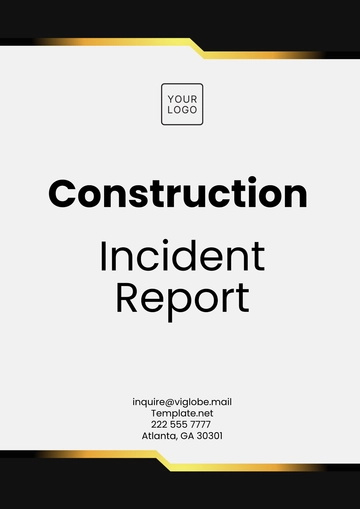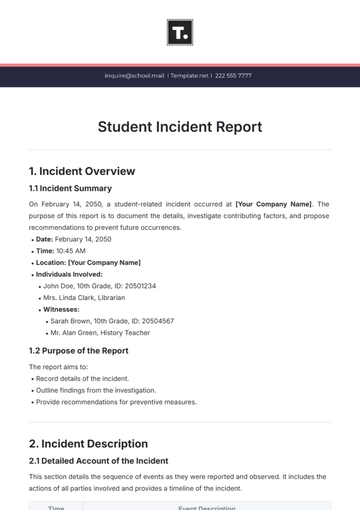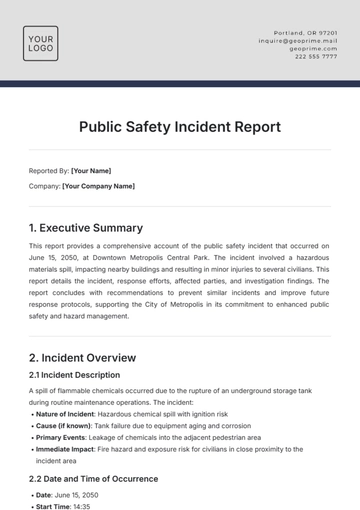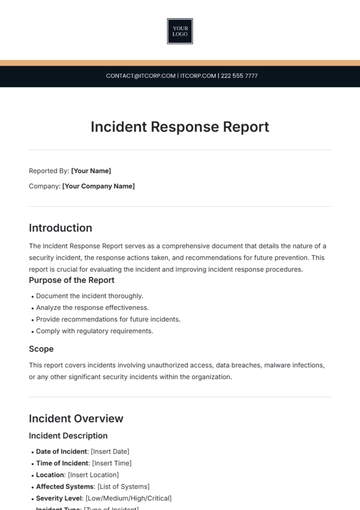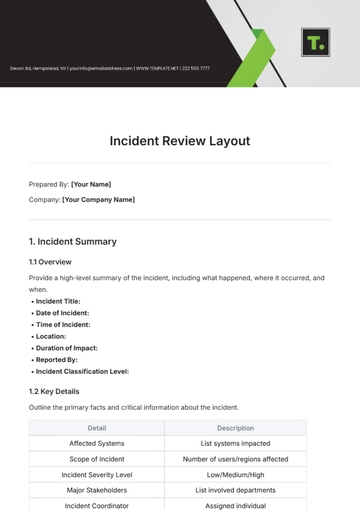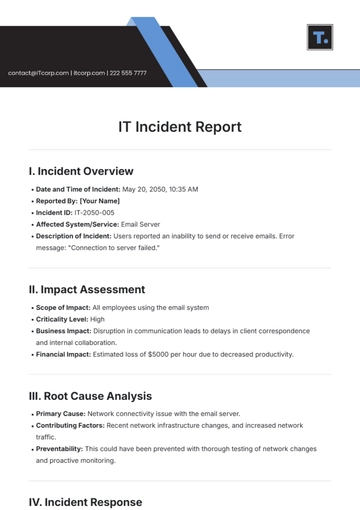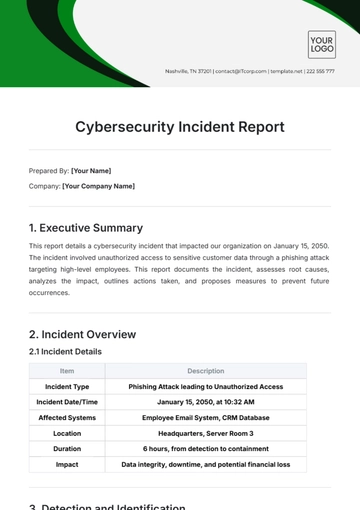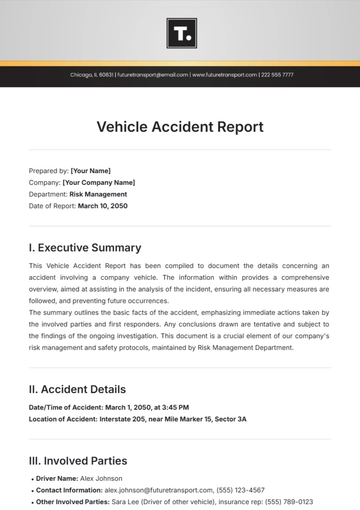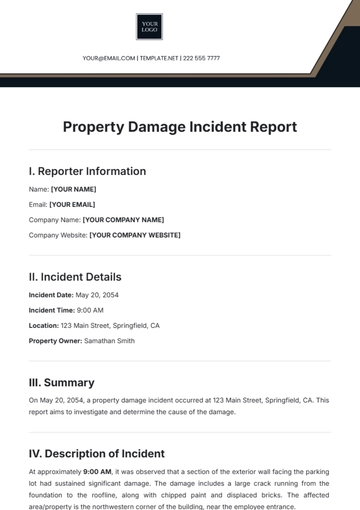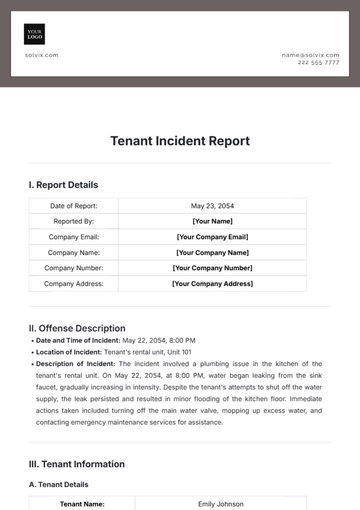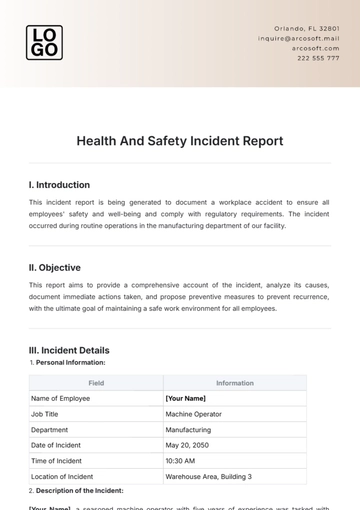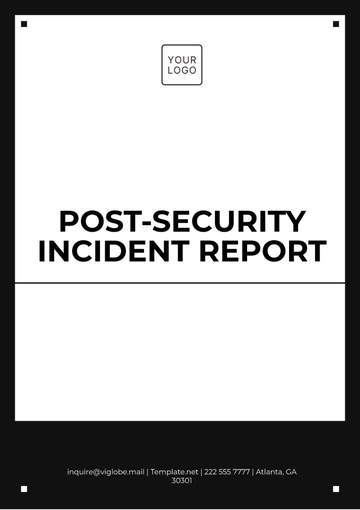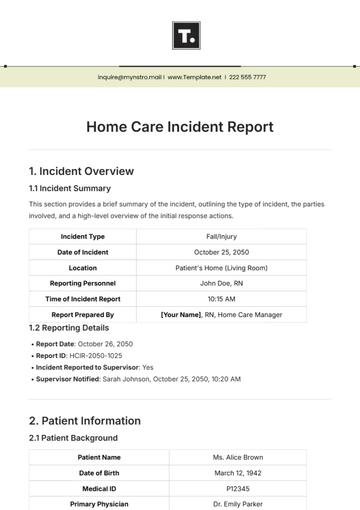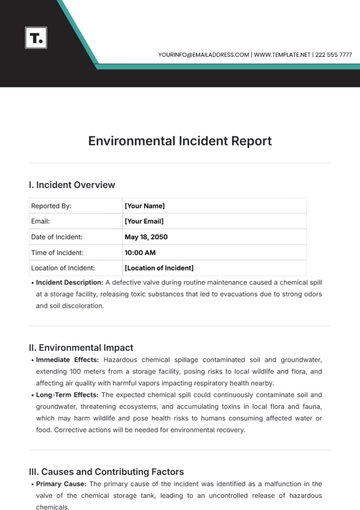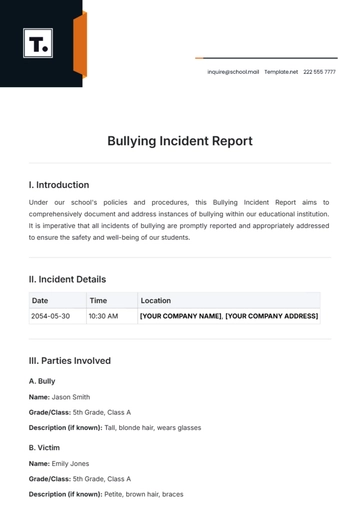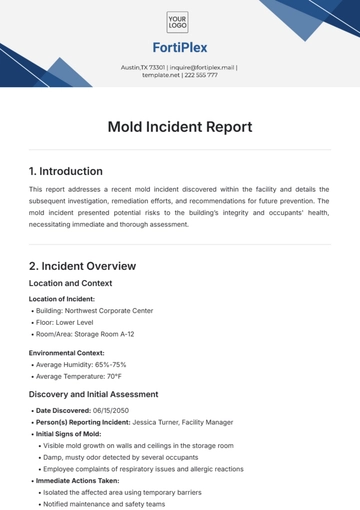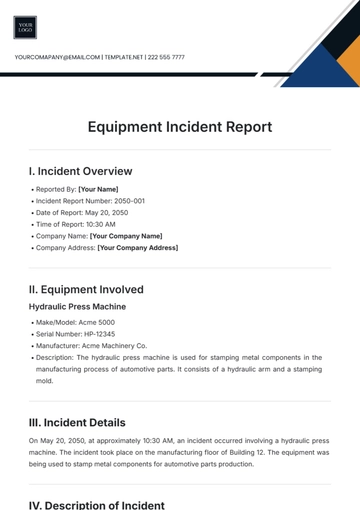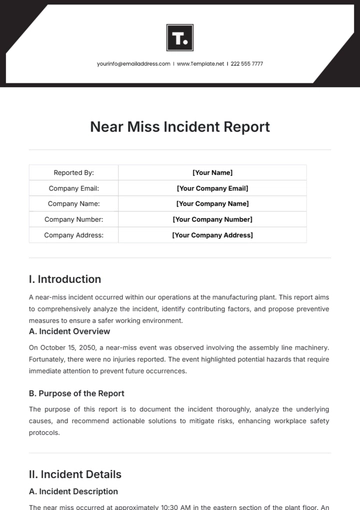Free Community Center Incident Report
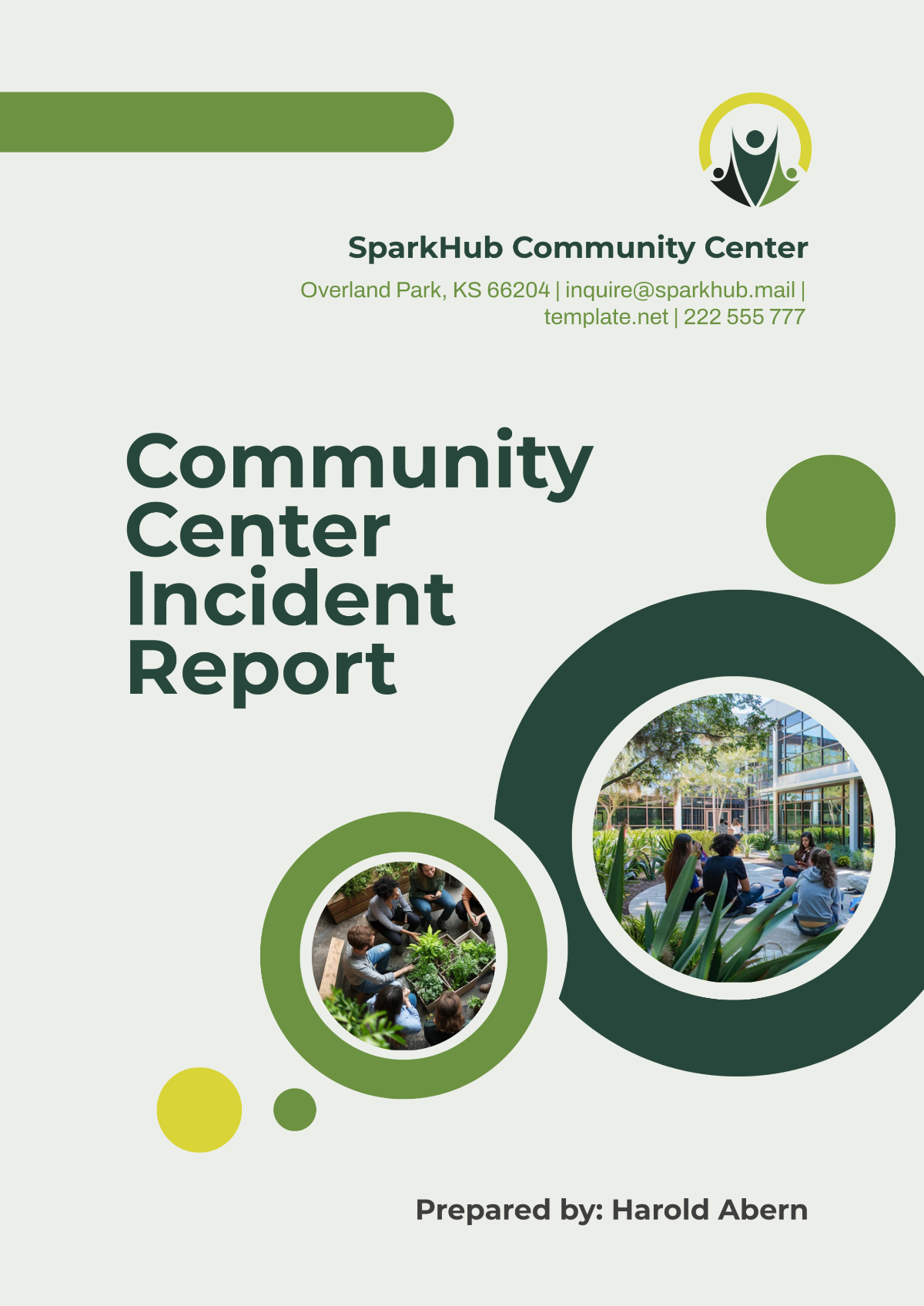
I. Incident Details
A. Type of Incident
The incident involved a minor injury sustained during a fitness class at the community center’s gymnasium. The participant, [Participant's Name], slipped while attempting a stretch and fell onto the floor, resulting in a bruised left knee. The fall occurred unexpectedly as [Participant's Name] attempted a high stretch, and the gym floor was free of any visible hazards. No additional injuries or incidents involving property damage or other individuals were reported at the time.
B. Description of Incident
As [Participant's Name] was engaged in a dynamic stretching movement, she lost her balance and fell forward onto her left knee. She immediately felt pain but was able to communicate with the instructor, who stopped the class to focus on her safety. Staff members were quickly alerted, and first aid was administered within minutes to stabilize the injury. After ensuring [Participant's Name] was comfortable and stable, staff evaluated the need for further medical attention, but it was determined that immediate medical assistance was not necessary.
C. People Involved
The injured participant, [Participant's Name], is a 35-year-old woman who has attended previous fitness classes at the center. The instructor, John Smith, is a certified fitness trainer who immediately took charge of the situation and provided first aid. The other three participants, who witnessed the incident, were not injured but were asked to leave the area for their own safety and to avoid further distraction. [Participant's Name]’s emergency contact information was also gathered to ensure she had support after the incident.
II. Incident Response
A. Actions Taken by Staff
Once the fall occurred, the instructor quickly assessed [Participant's Name]’s condition and administered first aid to manage the pain and swelling on her knee. A staff member was dispatched to alert the center’s medical team, while another staff member ensured the area was cleared to prevent any further accidents. [Participant's Name] was helped into a sitting position, and the fitness class was immediately paused to avoid any further disruptions. An incident report was filled out while [Participant's Name] was attended to, and the rest of the participants were escorted to a different area of the facility.
B. Law Enforcement or Emergency Services Involvement
Since [Participant's Name]'s injury appeared to be non-life-threatening, emergency services were not contacted, and the situation was handled internally by the center’s medical team. However, as a precaution, staff did monitor [Participant's Name]’s condition closely and advised her to seek further medical evaluation if any discomfort persisted. The on-site medical team was prepared to transport [Participant's Name] to a nearby clinic if her condition worsened, but she declined further immediate medical intervention. No law enforcement or public emergency services were involved in this incident.
C. Follow-Up Actions
Following the immediate response, [Participant's Name] was advised to rest her knee and apply ice for the next few hours, with instructions to consult a healthcare provider if her symptoms persisted. The center's management initiated a review of gym safety procedures to ensure similar incidents could be prevented in the future. [Participant's Name] was also informed about the option to file a claim with the center’s insurance provider for any medical expenses related to the injury, should she choose to do so. Lastly, the instructor was reminded to provide clearer safety guidelines and warm-up instructions in future classes to reduce the risk of similar accidents.
III. Damages or Injuries
A. Physical Injuries
[Participant's Name] suffered a bruise on her left knee, which was classified as a moderate injury that did not require stitches or advanced medical intervention. The injury caused temporary discomfort, but [Participant's Name] was able to walk, albeit with some difficulty. Medical staff assessed the injury and advised her to apply ice and rest for the next 24 hours.
B. Property Damage
No property damage occurred during the incident. The gym floor was inspected after the event, and it was determined that the floor mats were intact and there were no hazards that contributed to the fall. A routine cleaning was carried out to ensure the floor was free of any dust or debris that could have caused a slippery condition.
C. Emotional or Psychological Impact
[Participant's Name] experienced mild distress following the incident, though she was reassured by both the instructor and medical staff that her injury was not severe. While she was initially upset, she seemed to recover emotionally after being provided with a brief explanation of the injury’s nature. No additional emotional support was sought, but counseling was offered to her as an option should she experience further anxiety.
IV. Incident Documentation
A. Visual Evidence
Photos of the area where [Participant's Name] fell were taken to document the incident location, showing the gym environment and the positioning of the mats. The injury to [Participant's Name]’s knee was photographed to provide visual evidence for both the report and insurance purposes. A diagram of the gym layout was also created to show the placement of equipment relative to where the incident occurred.
B. Report Attachments
Along with the incident report, witness statements from the instructor and other participants were attached to provide a comprehensive account of the event. [Participant's Name]’s medical assessment, conducted by the community center’s healthcare team, was included to document the injury’s severity and the actions taken. A copy of the insurance claim report was also submitted to the center’s provider for further processing.
V. Root Cause and Contributing Factors
A. Analysis of the Incident
The primary cause of the incident was [Participant's Name]’s loss of balance during the stretching exercise, which led to the fall. While the gym floor was clean and well-maintained, a buildup of dust may have contributed slightly to the reduced traction on the surface. There was no indication of faulty equipment or any other immediate hazards that led to the injury.
B. Contributing Factors
The instructor may not have provided a clear enough warning regarding the intensity level of the class and the potential for slips. Additionally, [Participant's Name] may not have fully warmed up before engaging in more strenuous stretches, increasing her risk of losing balance. The lighting in the gymnasium could also be a factor, as it was slightly dimmed during the class, which might have contributed to her lack of visibility during the stretch.
VI. Corrective Actions and Preventive Measures
A. Immediate Corrective Actions
Following the incident, the gymnasium floor was immediately cleaned and inspected to ensure no dust or debris remained that could cause further accidents. [Participant's Name] was advised to rest for the remainder of the day and apply ice to her knee, and staff provided her with information on managing mild injuries at home. The fitness class was halted for the day to ensure all participants were safely escorted out and no further incidents occurred.
B. Long-Term Preventive Measures
The community center will implement mandatory warm-up sessions before all fitness classes to ensure participants are properly prepared for physical activity. Additionally, the center plans to increase the frequency of gym floor cleaning, particularly before and after fitness classes, to reduce the likelihood of slips and falls. Staff members will also undergo further training to reinforce the importance of safety instructions and to be more proactive in identifying potential risks during classes.
VII. Recommendations for Policy or Procedure Changes
A. Suggested Policy Updates
It is recommended that the community center implement a formal, written policy regarding pre-class warm-up exercises for all fitness sessions. This policy should be communicated to all participants at the time of registration and during the first moments of class. Additionally, a review of all gym equipment and safety procedures will be conducted quarterly to address any overlooked hazards or inefficiencies.
B. Staff or Community Education
There should be a greater focus on educating both staff and community members about safety protocols in fitness environments. Staff will undergo refresher courses on providing clear instructions and assessing the physical readiness of participants before engaging in strenuous activities. For the community, a safety briefing will be incorporated into the registration process for fitness programs, making participants aware of the importance of proper warm-ups, hydration, and equipment usage.
VIII. Review and Signatures
A. Report Prepared By
This report was prepared by [Manager's Name], Facility Manager, with input from the center's medical and safety teams. All details have been reviewed to ensure accuracy and completeness in documenting the incident.
 [Manager's Name]
[Manager's Name]
[Date]
B. Review and Approval
The incident report was reviewed and approved by [Supervisor's Name], Operations Supervisor, who has verified that all necessary follow-up actions will be taken. [Supervisor's Name] also affirmed that all corrective actions are in place to reduce the risk of similar incidents.
 [Supervisor's Name]
[Supervisor's Name]
[Date]
- 100% Customizable, free editor
- Access 1 Million+ Templates, photo’s & graphics
- Download or share as a template
- Click and replace photos, graphics, text, backgrounds
- Resize, crop, AI write & more
- Access advanced editor
Ensure a smooth and efficient documentation process with the Community Center Incident Report Template from Template.net. This editable and customizable template allows you to easily record and manage incident details with the help of an intuitive AI Editor Tool. Tailor it to your center’s specific needs, ensuring thorough and professional reports every time.
You may also like
- Sales Report
- Daily Report
- Project Report
- Business Report
- Weekly Report
- Incident Report
- Annual Report
- Report Layout
- Report Design
- Progress Report
- Marketing Report
- Company Report
- Monthly Report
- Audit Report
- Status Report
- School Report
- Reports Hr
- Management Report
- Project Status Report
- Handover Report
- Health And Safety Report
- Restaurant Report
- Construction Report
- Research Report
- Evaluation Report
- Investigation Report
- Employee Report
- Advertising Report
- Weekly Status Report
- Project Management Report
- Finance Report
- Service Report
- Technical Report
- Meeting Report
- Quarterly Report
- Inspection Report
- Medical Report
- Test Report
- Summary Report
- Inventory Report
- Valuation Report
- Operations Report
- Payroll Report
- Training Report
- Job Report
- Case Report
- Performance Report
- Board Report
- Internal Audit Report
- Student Report
- Monthly Management Report
- Small Business Report
- Accident Report
- Call Center Report
- Activity Report
- IT and Software Report
- Internship Report
- Visit Report
- Product Report
- Book Report
- Property Report
- Recruitment Report
- University Report
- Event Report
- SEO Report
- Conference Report
- Narrative Report
- Nursing Home Report
- Preschool Report
- Call Report
- Customer Report
- Employee Incident Report
- Accomplishment Report
- Social Media Report
- Work From Home Report
- Security Report
- Damage Report
- Quality Report
- Internal Report
- Nurse Report
- Real Estate Report
- Hotel Report
- Equipment Report
- Credit Report
- Field Report
- Non Profit Report
- Maintenance Report
- News Report
- Survey Report
- Executive Report
- Law Firm Report
- Advertising Agency Report
- Interior Design Report
- Travel Agency Report
- Stock Report
- Salon Report
- Bug Report
- Workplace Report
- Action Report
- Investor Report
- Cleaning Services Report
- Consulting Report
- Freelancer Report
- Site Visit Report
- Trip Report
- Classroom Observation Report
- Vehicle Report
- Final Report
- Software Report
